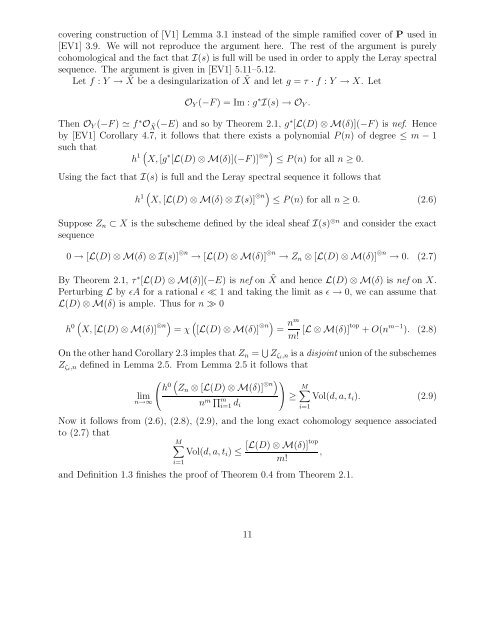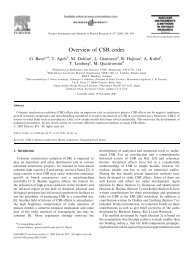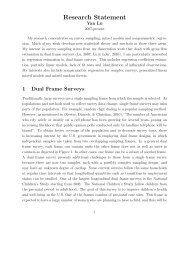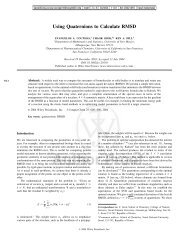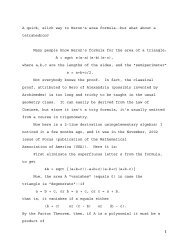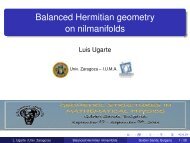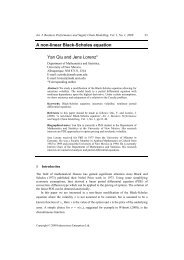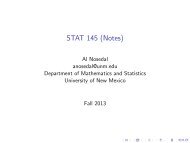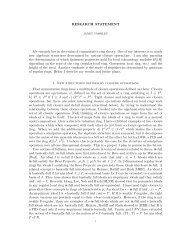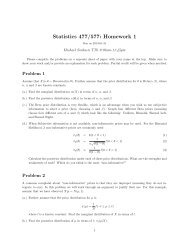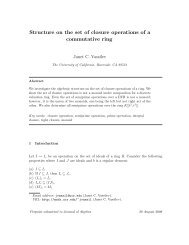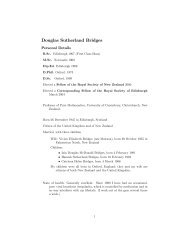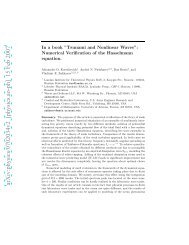Dyson's Lemma and a Theorem of Esnault and Viehweg
Dyson's Lemma and a Theorem of Esnault and Viehweg
Dyson's Lemma and a Theorem of Esnault and Viehweg
Create successful ePaper yourself
Turn your PDF publications into a flip-book with our unique Google optimized e-Paper software.
covering construction <strong>of</strong> [V1] <strong>Lemma</strong> 3.1 instead <strong>of</strong> the simple ramified cover <strong>of</strong> P used in[EV1] 3.9. We will not reproduce the argument here. The rest <strong>of</strong> the argument is purelycohomological <strong>and</strong> the fact that I(s) is full will be used in order to apply the Leray spectralsequence. The argument is given in [EV1] 5.11–5.12.Let f : Y → ˜X be a desingularization <strong>of</strong> ˜X <strong>and</strong> let g = τ · f : Y → X. LetO Y (−F) = Im : g ∗ I(s) → O Y .Then O Y (−F) ≃ f ∗ O ˜X(−E) <strong>and</strong> so by <strong>Theorem</strong> 2.1, g ∗ [L(D) ⊗ M(δ)](−F) is nef. Henceby [EV1] Corollary 4.7, it follows that there exists a polynomial P(n) <strong>of</strong> degree ≤ m − 1such thath 1 ( X, [g ∗ [L(D) ⊗ M(δ)](−F)] ⊗n) ≤ P(n) for all n ≥ 0.Using the fact that I(s) is full <strong>and</strong> the Leray spectral sequence it follows thath 1 ( X, [L(D) ⊗ M(δ) ⊗ I(s)] ⊗n) ≤ P(n) for all n ≥ 0. (2.6)Suppose Z n ⊂ X is the subscheme defined by the ideal sheaf I(s) ⊗n <strong>and</strong> consider the exactsequence0 → [L(D) ⊗ M(δ) ⊗ I(s)] ⊗n → [L(D) ⊗ M(δ)] ⊗n → Z n ⊗ [L(D) ⊗ M(δ)] ⊗n → 0. (2.7)By <strong>Theorem</strong> 2.1, τ ∗ [L(D) ⊗ M(δ)](−E) is nef on ˜X <strong>and</strong> hence L(D) ⊗ M(δ) is nef on X.Perturbing L by ǫA for a rational ǫ ≪ 1 <strong>and</strong> taking the limit as ǫ → 0, we can assume thatL(D) ⊗ M(δ) is ample. Thus for n ≫ 0h 0 ( X, [L(D) ⊗ M(δ)] ⊗n) = χ ( [L(D) ⊗ M(δ)] ⊗n) = nmm! [L ⊗ M(δ)]top + O(n m−1 ). (2.8)On the other h<strong>and</strong> Corollary 2.3 imples that Z n = ⋃ Z ζi ,n is a disjoint union <strong>of</strong> the subschemesZ ζi ,n defined in <strong>Lemma</strong> 2.5. From <strong>Lemma</strong> 2.5 it follows thatlimn→∞⎛⎝ h0 ( Z n ⊗ [L(D) ⊗ M(δ)] ⊗n)n m ∏ mi=1 d i⎞M∑⎠ ≥ Vol(d, a, t i ). (2.9)i=1Now it follows from (2.6), (2.8), (2.9), <strong>and</strong> the long exact cohomology sequence associatedto (2.7) thatM∑ [L(D) ⊗ M(δ)]topVol(d, a, t i ) ≤ ,m!i=1<strong>and</strong> Definition 1.3 finishes the pro<strong>of</strong> <strong>of</strong> <strong>Theorem</strong> 0.4 from <strong>Theorem</strong> 2.1.11


